Kendall Valley is as gorgeous in the morning as it was the night before. Dawn breaks cold and clear with cloudless pale blue skies. We take advantage of Sparky and Dave’s (the friendly staff) hospitality and enjoy the availability of hot tea and anything including bacon. Don’t get me wrong, Molly’s oatmeal is divine…but bacon is a sinful and welcome treat on a cold morning.
I skate across the frosty surface of the wooden boardwalk from our cabin to the bunkhouse and say hello to Chubbs the one-eyed blue heeler and his companion Jack Russell on the way to the lodge for breakfast. Molly and Tammy take advantage of the wifi and pork products too.
We pack up and load bikes, checking oil, chains and small details before getting out on the highway. I spy a clump of sage leaves caught in one of my saddlebag buckles, testimony to the tight corners I took late in the day yesterday.


The map leads us from here to Cora and then to Pinedale and further southeast before getting off the asphalt again after Boulder.
As we ride south toward Cora, Molly pulls off the road to check out a roadkill badger that has dried to the appearance of an old cowpatty. Tammy and I pull over and wait and then each walk back to see what she’s up to. Molly has decided to take his lower jaw bone and skull along with her to add to her collection of animal skulls back in Maine. It’s just one of many interesting things I love about her, her fascination with nature.

 She found a seal vertebrae on her ride through northern Vancouver Island earlier this summer, and has an antler as well from some other part of this trip. Her souvenirs are mounted to her bike.
She found a seal vertebrae on her ride through northern Vancouver Island earlier this summer, and has an antler as well from some other part of this trip. Her souvenirs are mounted to her bike. 

We fuel up in Pinedale and since I’m still navigating for our group, I check my maps to have an idea where we turn off the highway.

I lead us to Boulder and turn there taking the 353 into the desert foothills of the Wind River Range. We stop at the Fremont Butte marker, one of dozens (if not hundreds) of historical markers along the CDT route, to take a look.
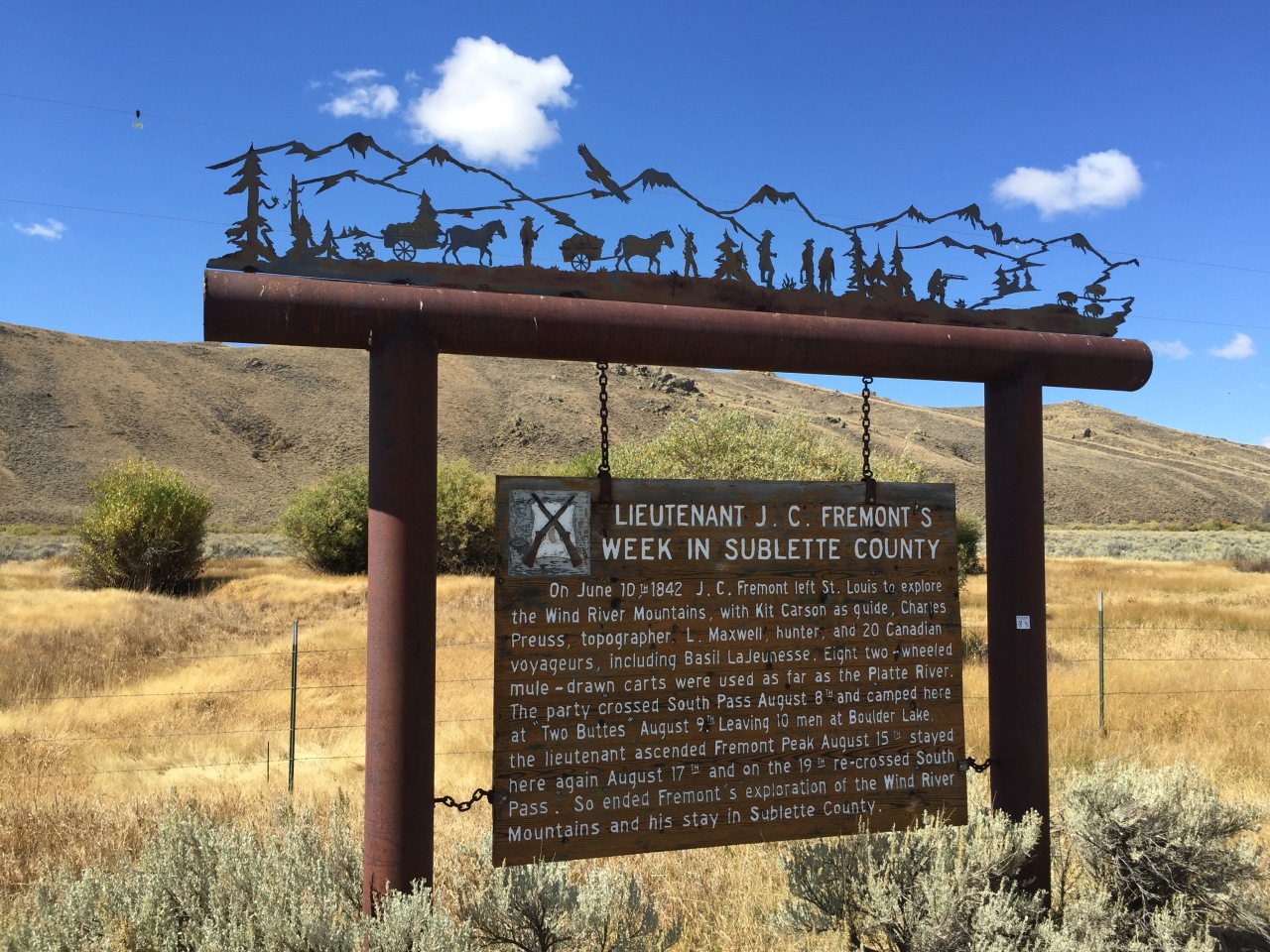
Big Sandy-Elkhorn Road leads us away from the river we have been following and up onto a high dry plain, winding all the way. The mountains to the north are stunning.
 We each stop for photos now and then, or for a roadside tinkle, and slowly make our way across the plateau. The sky seems enormous today. And without any wind, the conditions for riding are perfect.
We each stop for photos now and then, or for a roadside tinkle, and slowly make our way across the plateau. The sky seems enormous today. And without any wind, the conditions for riding are perfect.
Molly rides ahead while Tammy stops to pose her bike for a photo, and when we catch up she is waiting at the side of the road with an idea. I’ve pointed out a sheep wagon somewhere along the trail in the past few days, and shared with them that my paternal grandparents lived in one when they were first married. Molly has spotted another not far off the road, perched on a knoll with a breathtaking view of the blue mountains in the distance. She wonders if we are interested in going to take a look. I definitely am. Molly rides ahead while I turn on the GoPro and bring up the rear. We ride off the main gravel road to a dirt road and then over a small burm to a pair of wagon ruts that leads out to a small camp. As Molly parks, and Tammy and I ride up, I can see a small Hispanic man step out from behind the sheep wagon to see who has arrived.

Molly greets him while I take my helmet off and I can immediately hear him reply to her in Spanish, to which she replies by calling my name. Thankfully, one of my favorite souvenirs from my two-year motorcycle trip through the Americas is my ability to speak a little Spanish. I introduce myself and find out the shephard is named Hernado. He is here watching over a herd of 1000 head of sheep with the help of his two horses, Rojito and Blanco, and a half dozen dogs. Two Border Collies are here with him and seem very wary of the new visitors. Three or four large white dogs are out with the herd.
I explain to Hernado that we are traveling by motorcycle and saw his camp and hoped to take a closer look. I try to explain that my grandparents lived in a sheep wagon 60+ years ago, but something is lost in translation. He thinks I’m telling him they lived right here, but they lived in South Dakota. Anyway, he is pleasant and polite, if a little (understandably) reserved. Molly suggests I cook up the Indian curry that I had packed for our camp dinner tonight, so I ask Hernado if it would be alright if we stopped for lunch here at his camp and wondered if he would be interested in sharing our meal with us. He politely nods and accepts. As I return to the bike to get my stove and the curry packet and fresh zucchini and tomatoes for the meal, Hernado disappears into his wagon for a few moments. Later we find out he has straightened things up in advance of offering us a tour, and he has stoked up his wood stove so that we can use it to cook. I tell him we have our own stoves, but the fire is already blazing away so we thank him and take advantage of it.

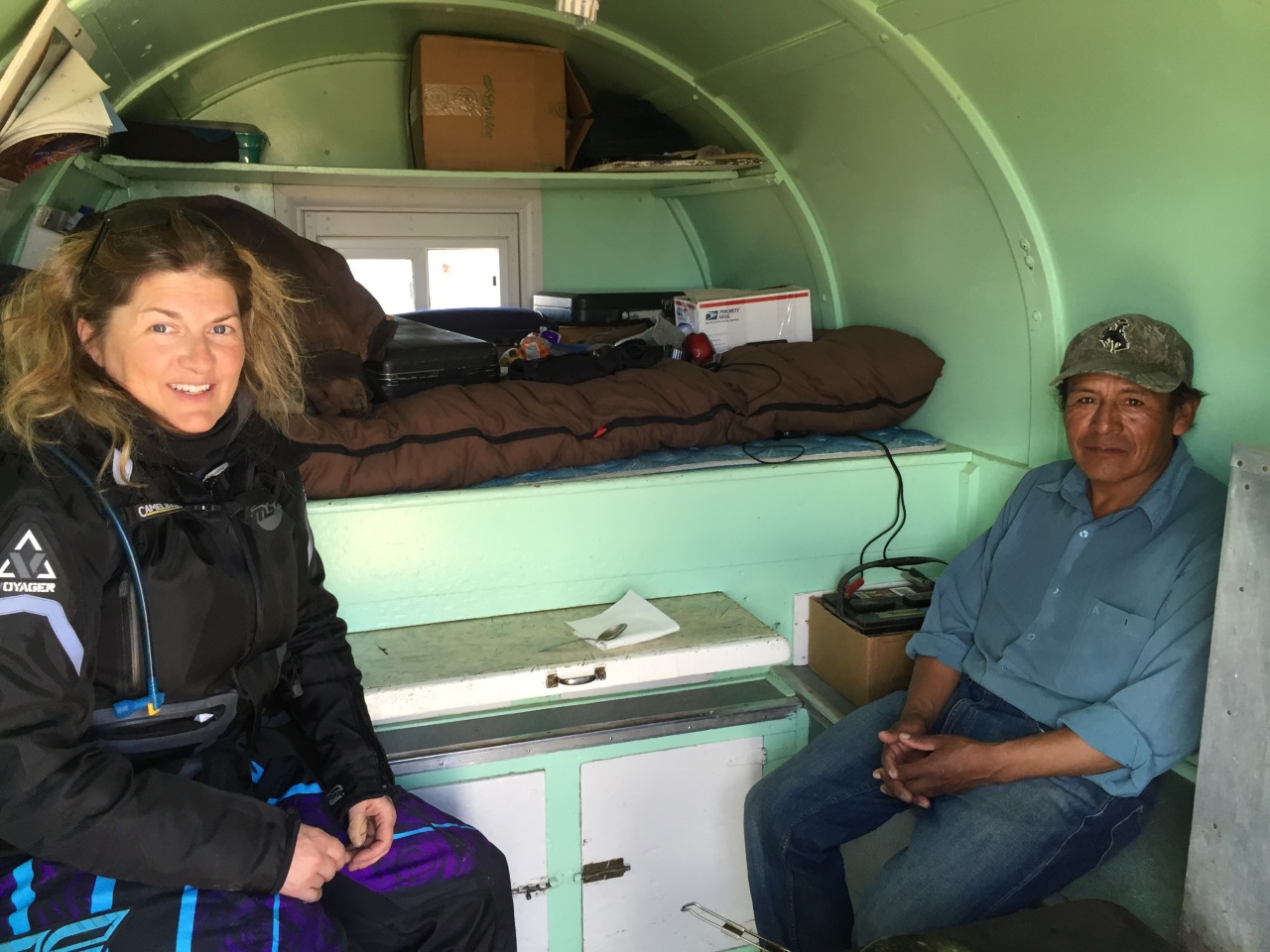



Tammy treats us to Newfoundland moose jerky while I cook up the curry and stretch it by adding a packet of Indian Lentils and some ready made rice. Hernado invites us inside, one at a time, to see the sheep wagon. I’m really impressed by how well insulated it must be, because it’s very quiet inside and very hot with the wood stove roaring by the front door. The view from his summer home is simply stunning.
Hernado is here for three months during the summer grazing season and will be returning to Colorado in mid-October when the owner comes to get him and the herd. As we visit, we find we are peeling back the layers of an onion, finding an even more interesting one beneath each last layer.
Hernado is from Huancayo, Peru. I explain that I have been to Peru and think his country is very beautiful. He seems surprised to encounter someone who has been there and we talk about Peru for a few minutes. He has been working in America for two summers and has a wife and several children back in Peru. We ask many questions, while I try to do my best to translate the conversation. We each find some food in our panniers to offer him for his hospitality. I make gifts of a banana and a slightly dented apple, as well as some oatmeal and chocolate-covered almonds.
Somewhere along the way we find out that he played in a band in Peru and when I ask which instrument he says, surprising me, that he plays the saxophone. I ask if he has it with him and he does. Perhaps being a bit too forward, I take a chance, and ask if he will play for us. Our involuntary host obliges us and goes inside to retrieve his shiny Italian sax to entertain us, perhaps his gift to us, in exchange for our offering him a small plate of rehydrated foreign food.


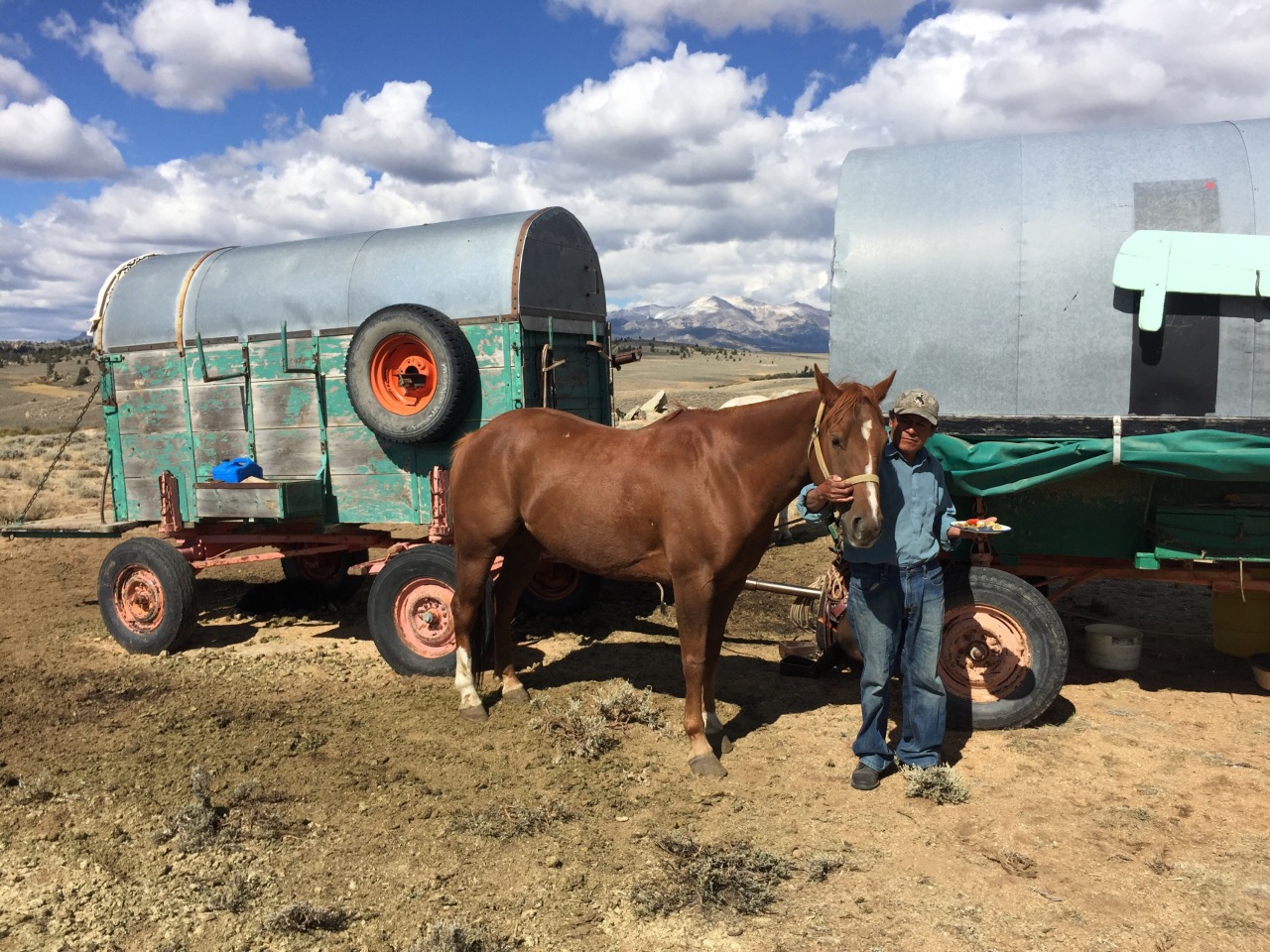
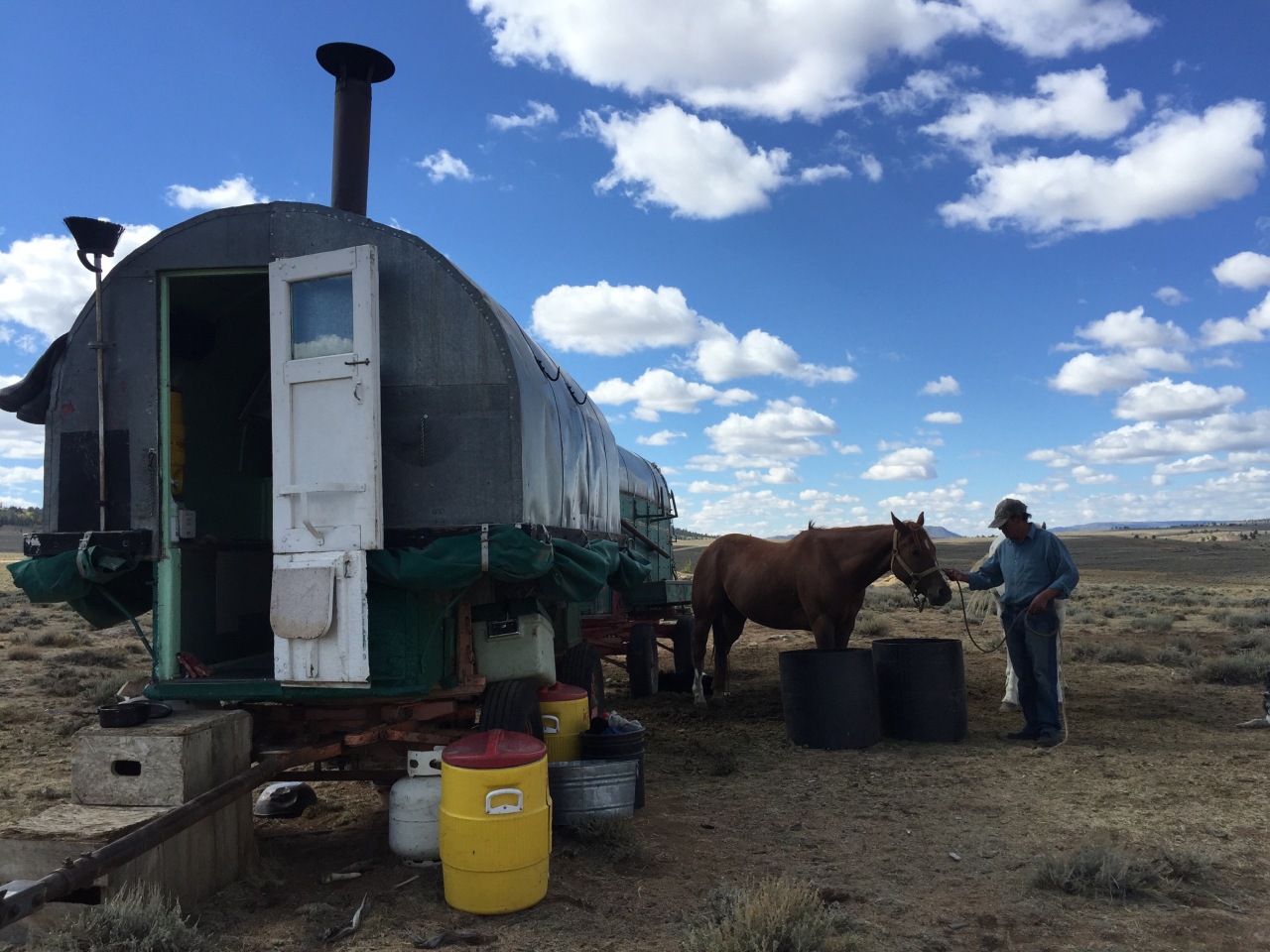



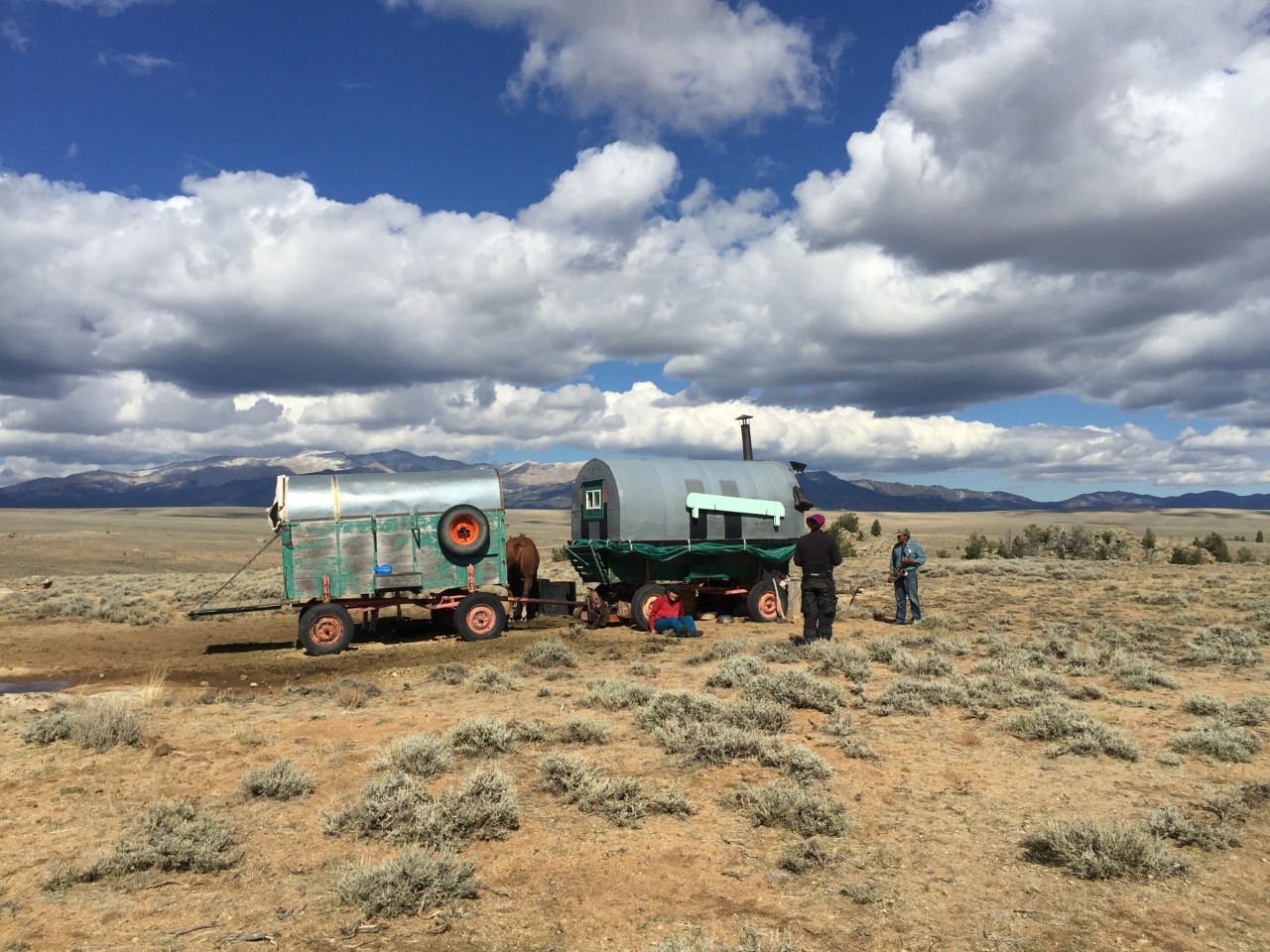
He plays us a few tunes, one of which Molly recognizes as similar to a Simon and Garfunkel song she knows. I wander around while he plays and snap a few pictures of the whole scene from a distance. For a moment, I pause, and try to take in the surreal afternoon playing out in front of me. All the makings of a good bar joke (a Canadian, a Maine-iac, and a South Dakotan are traveling by motorcycles in the mountains of Wyoming and pull off the side of the road at the camp of a Peruvian sheepherder who plays an Italian sax while they dine on moose and Indian food…) have instead come together in a way that moves me to tears. It’s an overwhelmingly beautiful brief moment at the intersection in the lives of four random members of the human race…and I’m so grateful to be one of the four. Molly jokes that “you can’t make this stuff up” as we pack up, and I know she feels it too.
I linger for a few minutes while putting away my dishes and closing up my saddlebags, to thank the higher power and universe for the gift of this beautiful experience, a momentary gift within the gift of this trip, within the gift that is my life.
We thank Hernado for his music and his hospitality and I give him a hug before we go. Gracias, amigo, and thank you for this beautiful day.

I cry all the way back to my bike and for the quarter-mile or so back to the main road. Happy, happy, thank-you-for-this-life tears.
And on we go down the road…
Miles of sage-covered altiplano carry us further east, finally delivering us to a highway which we have to take north for 5-6 miles before turning east again toward South Pass City.
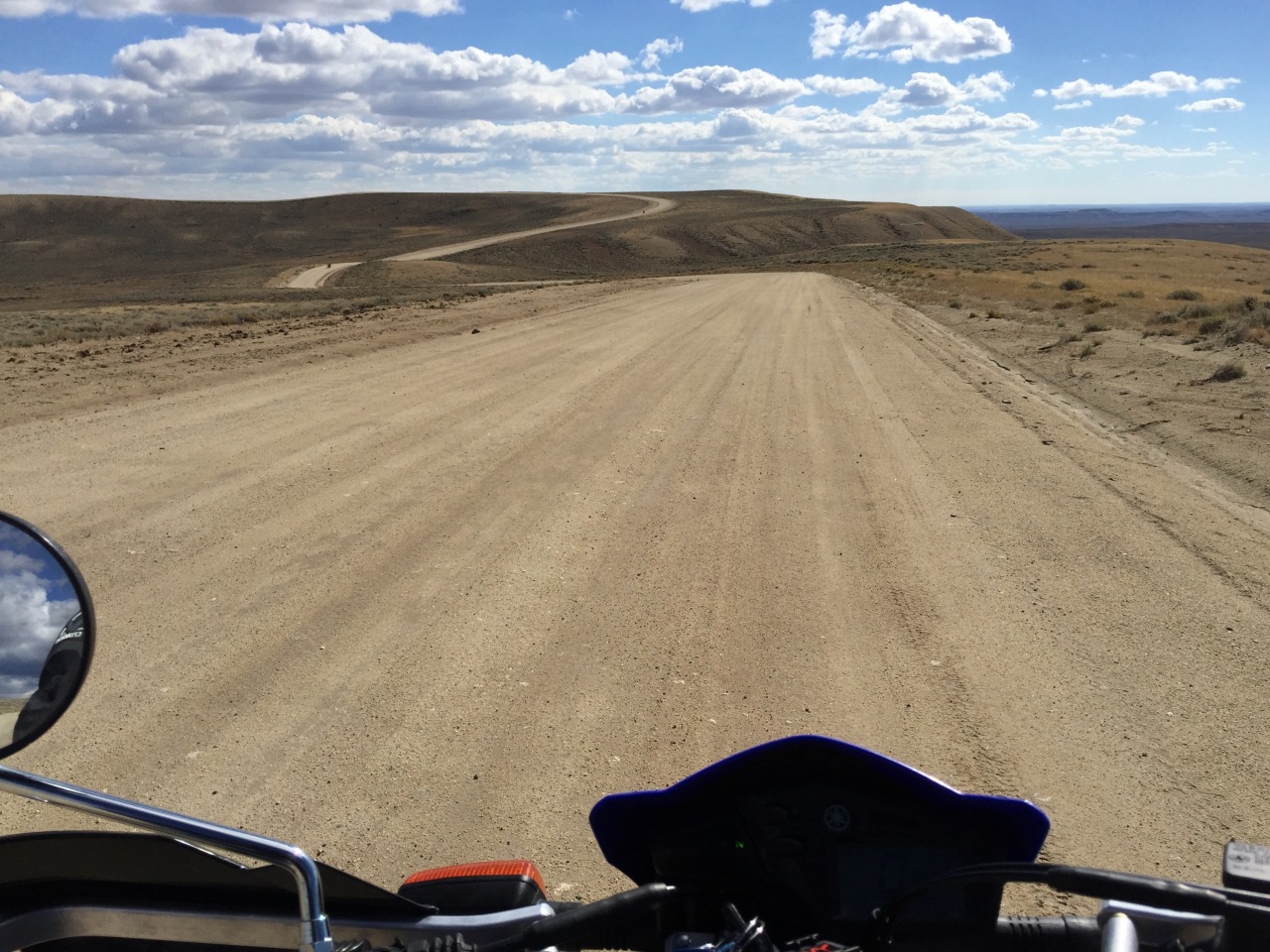
As we get back to the gravel after the short stint of asphalt, our road passes a small knoll of rock outcroppings, windswept scrub and tattered trees. We pull off the road to explore.

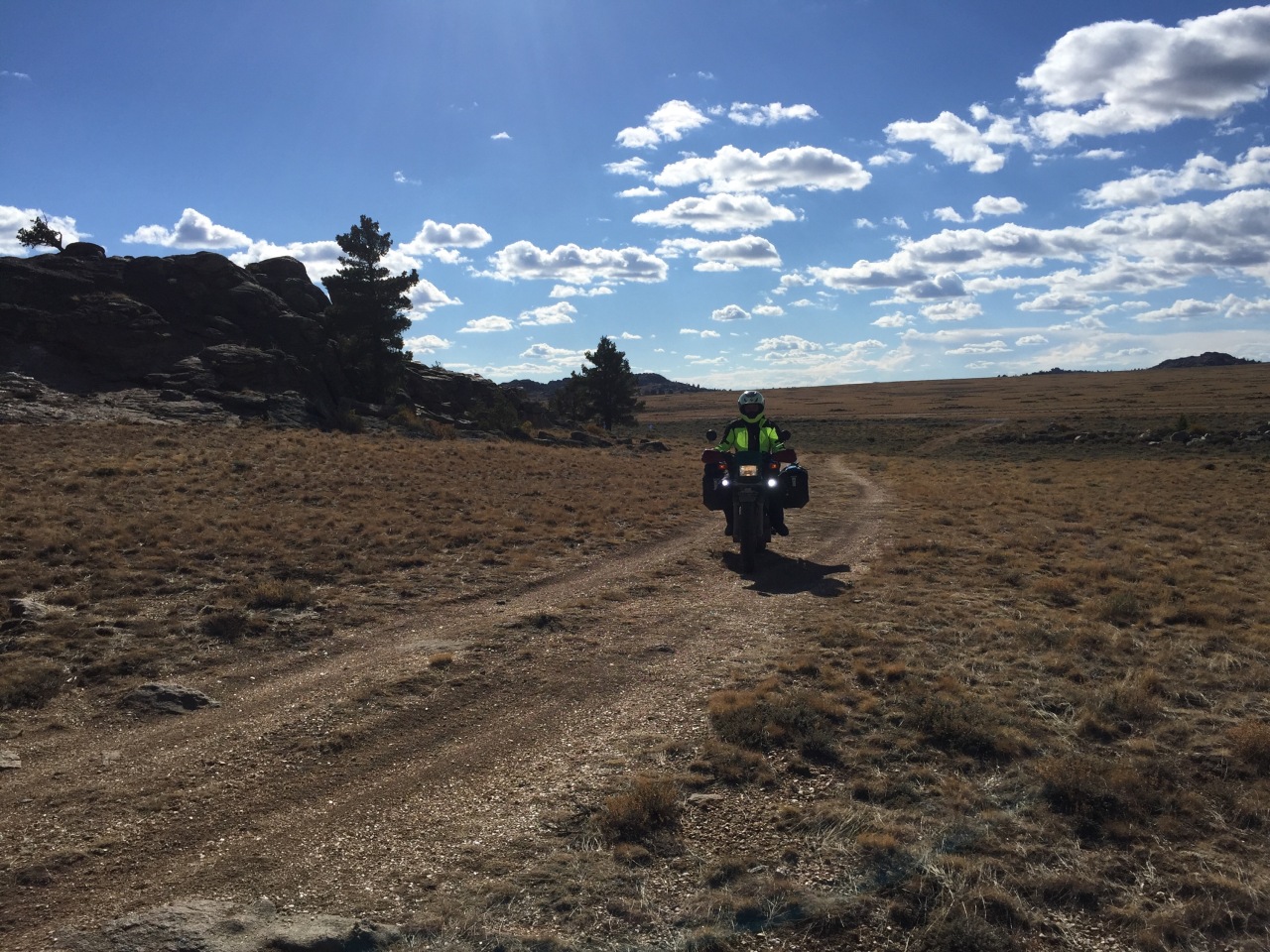
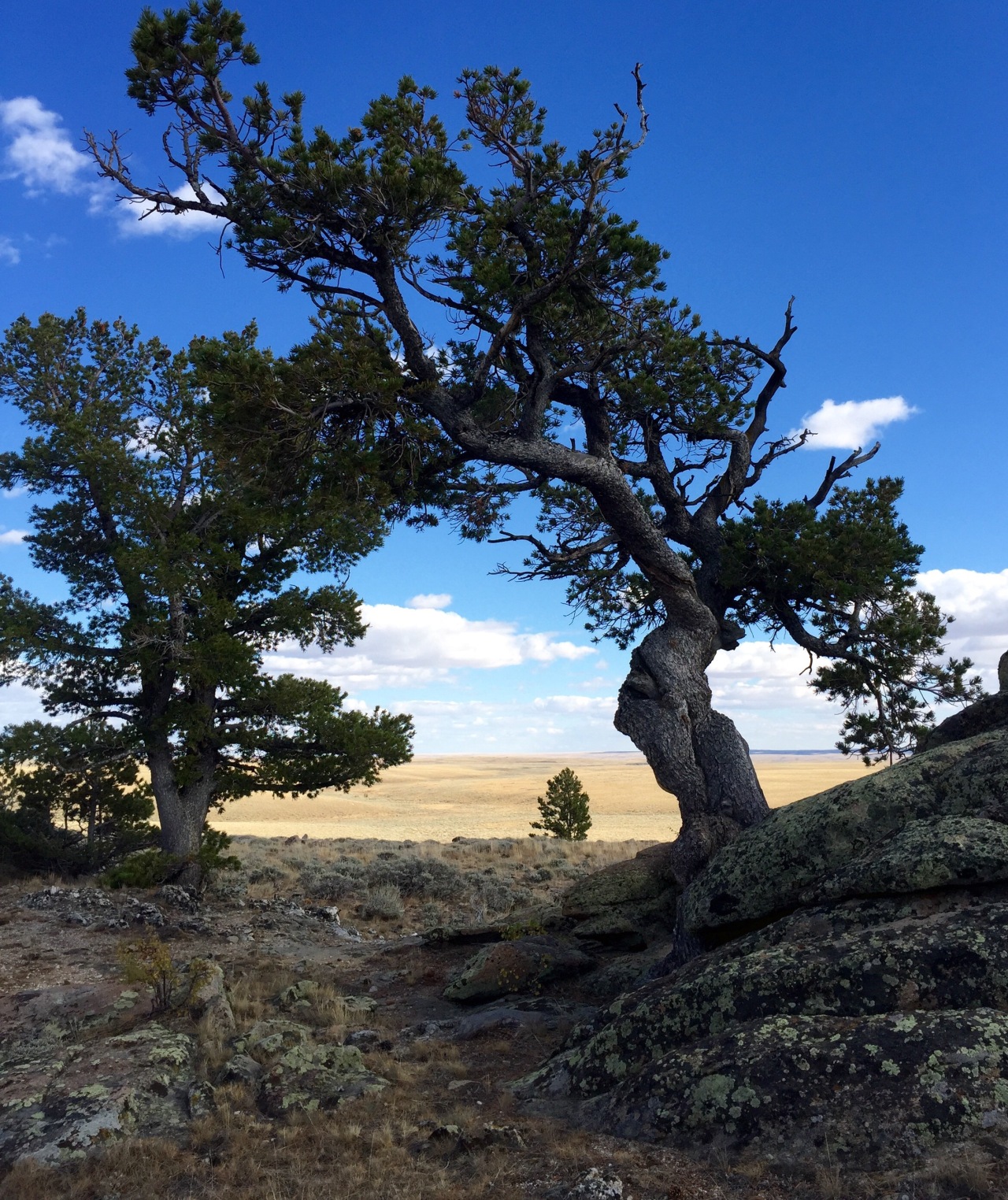
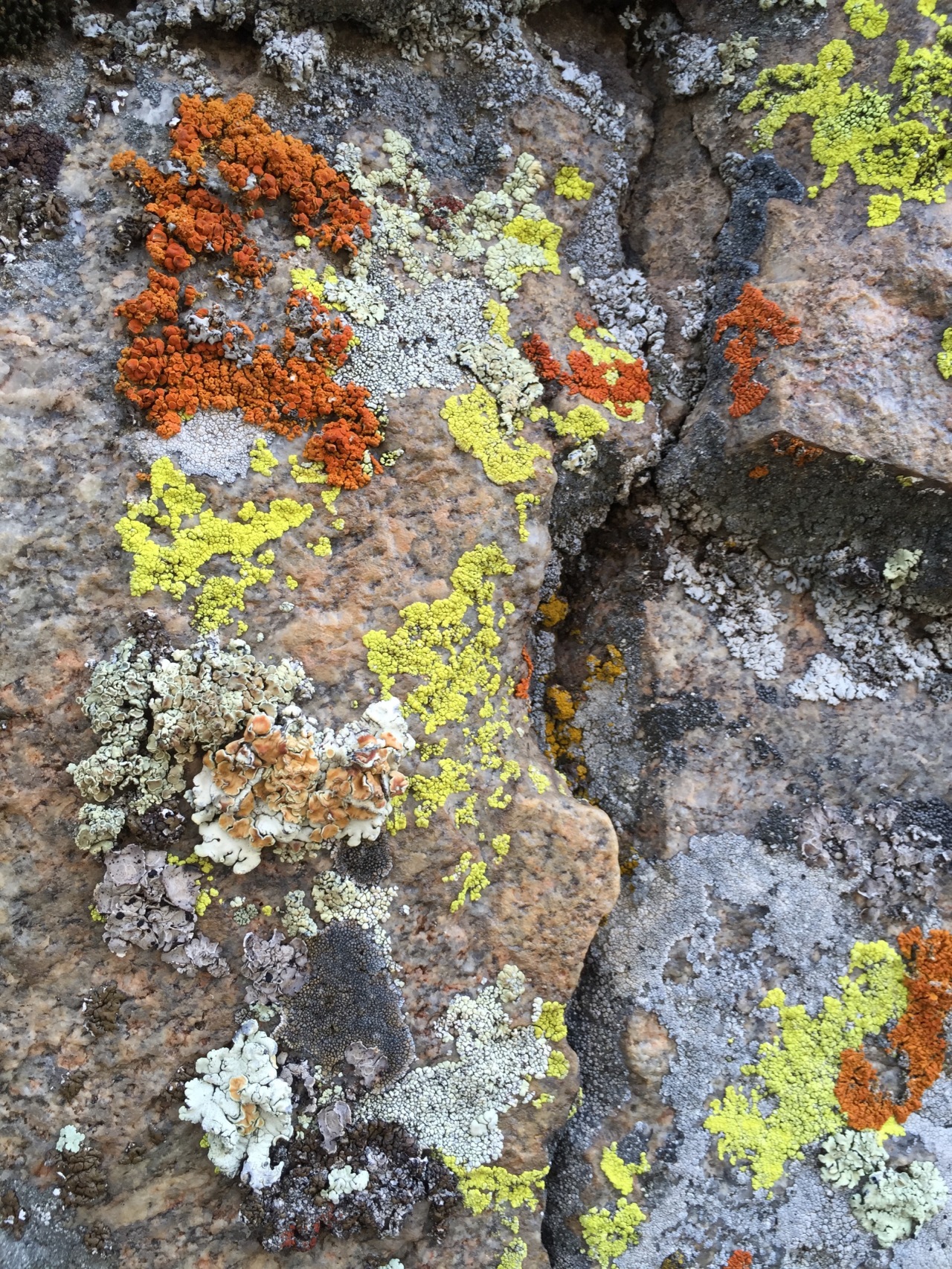
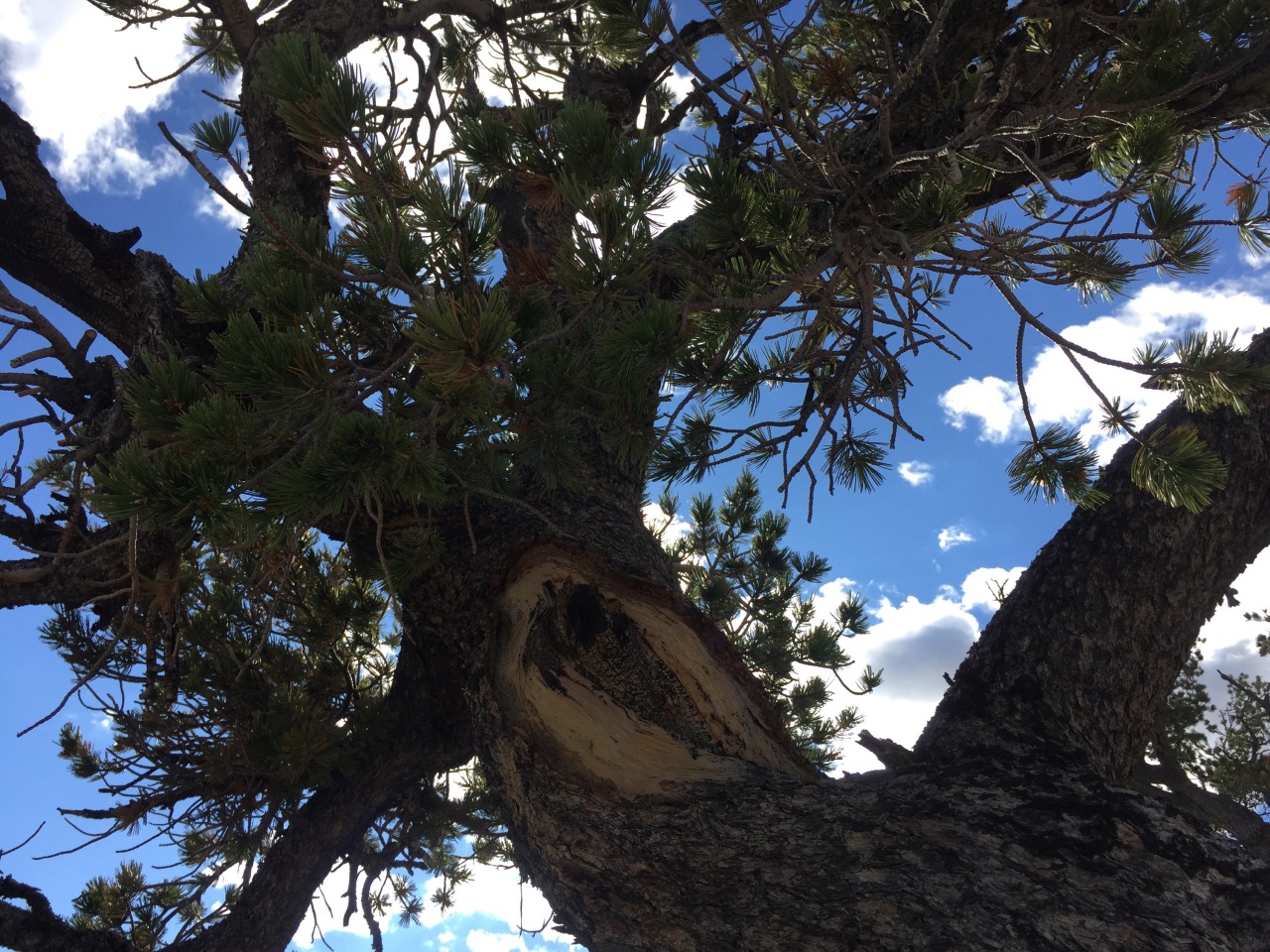


The afternoon is getting on, and we debate briefly about whether or not to camp here or carry on a bit. Tammy has had a short nap and suggests we keep moving, so we do.
We ride through South Pass City and stop briefly but find no services. We need fuel before this next long stretch of trail which will take us more than 130 miles through barren wasteland.

We keep moving, past the Carissa Mine and on to Atlantic City, where Molly jokes she hopes we can get lucky like people do in the other Atlantic City.


There’s no visible services in Atlantic City either though. But a quick stop at the pub leads Tammy and Molly to getting a tip for us. If we ride back to Wild Bill’s gun shop, which was back at the bottom of the hill as we rode into town, he might have some to sell us.
Sure enough he does. And he and Carmella are a wonderfully fun diversion for a few minutes of our day.
They direct us to the road that runs just past their place to lead us into the Great Divide Basin, which they refer to as the ‘desert’. The Continental Divide, is itself an imaginary line where the watershed of our country splits between water running west toward the Pacific or east toward the Atlantic. The Great Divide Basin is an anomoly on this trail in that it defies the watershed issue. All rain that comes down here stays in the basin by flowing into a handful of small lakes and streams or evaporating, thereby not shedding water to either side of America.
Bill suggests we camp near the Sweetwater River about 10 miles up the road. We thank them, buy some water, and head out to make camp before dark.
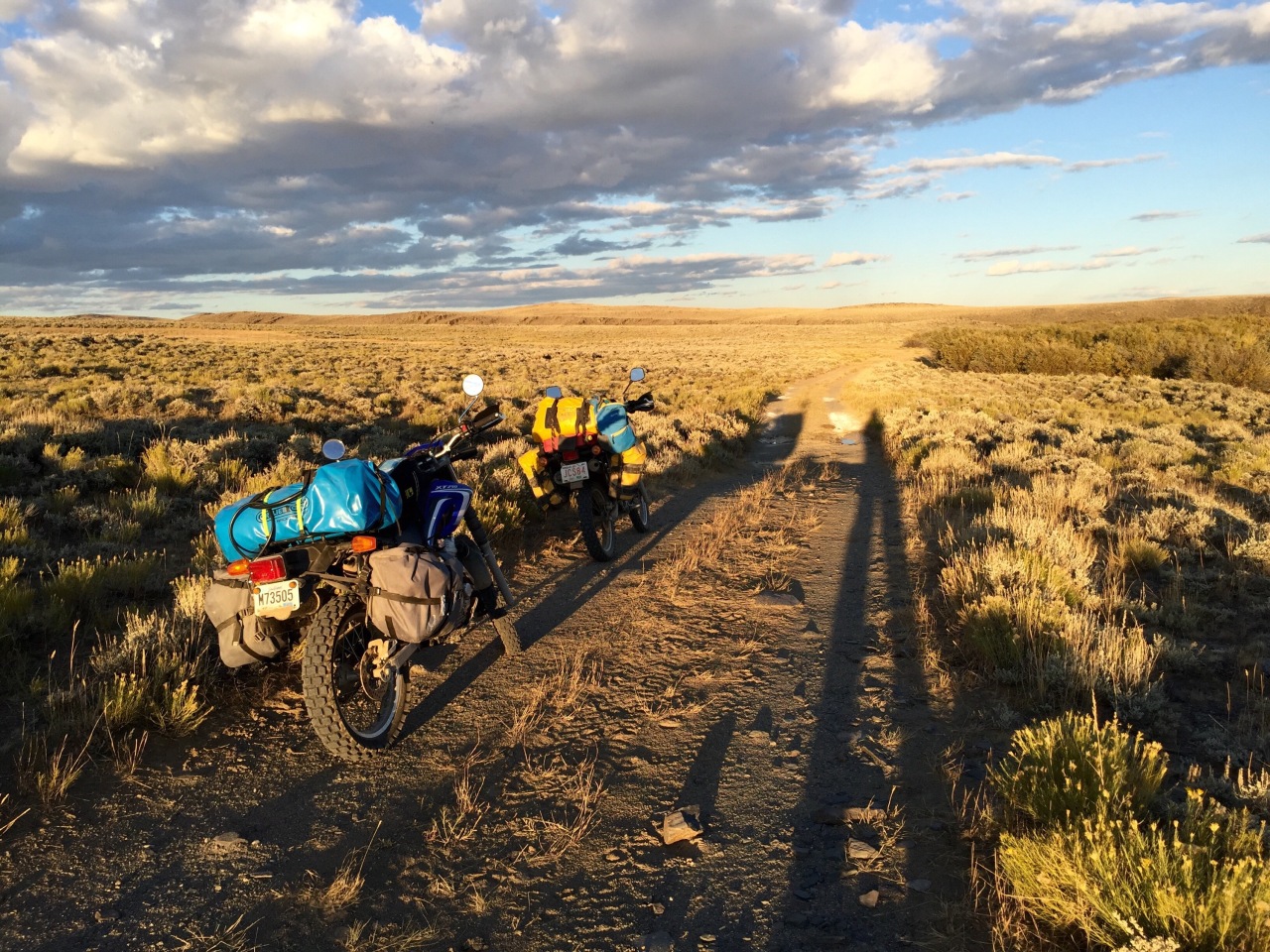 Our long shadows give a telltale warning of the coming end of daylight. The road is washboard covered and bumpy, but fast enough.
Our long shadows give a telltale warning of the coming end of daylight. The road is washboard covered and bumpy, but fast enough.


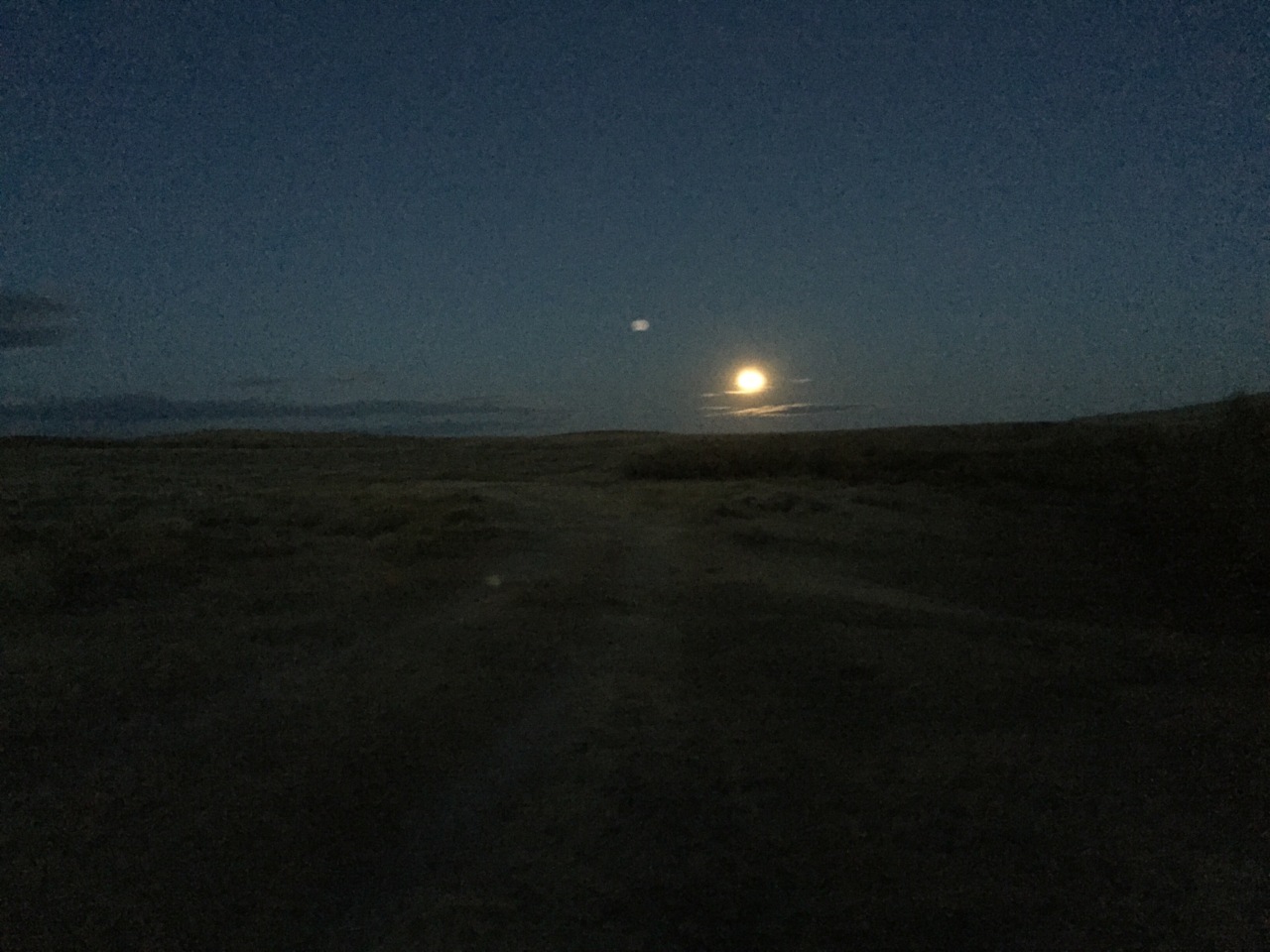
We ride down to the waters edge and find shelter between tall bushes and set to working making camp. There’s plenty of wood for a fire which Tammy promptly gets going. Everyone tears into canned sardines and beef jerky since we are safely out of bear country for the moment. Molly plays us an imaginary tune on the empty can left behind from her dinner and we giggle. Tammy tries a few fun perspective photos with the full moon rising in the east, and finally we each tuck in for the night.
What an incredible day.
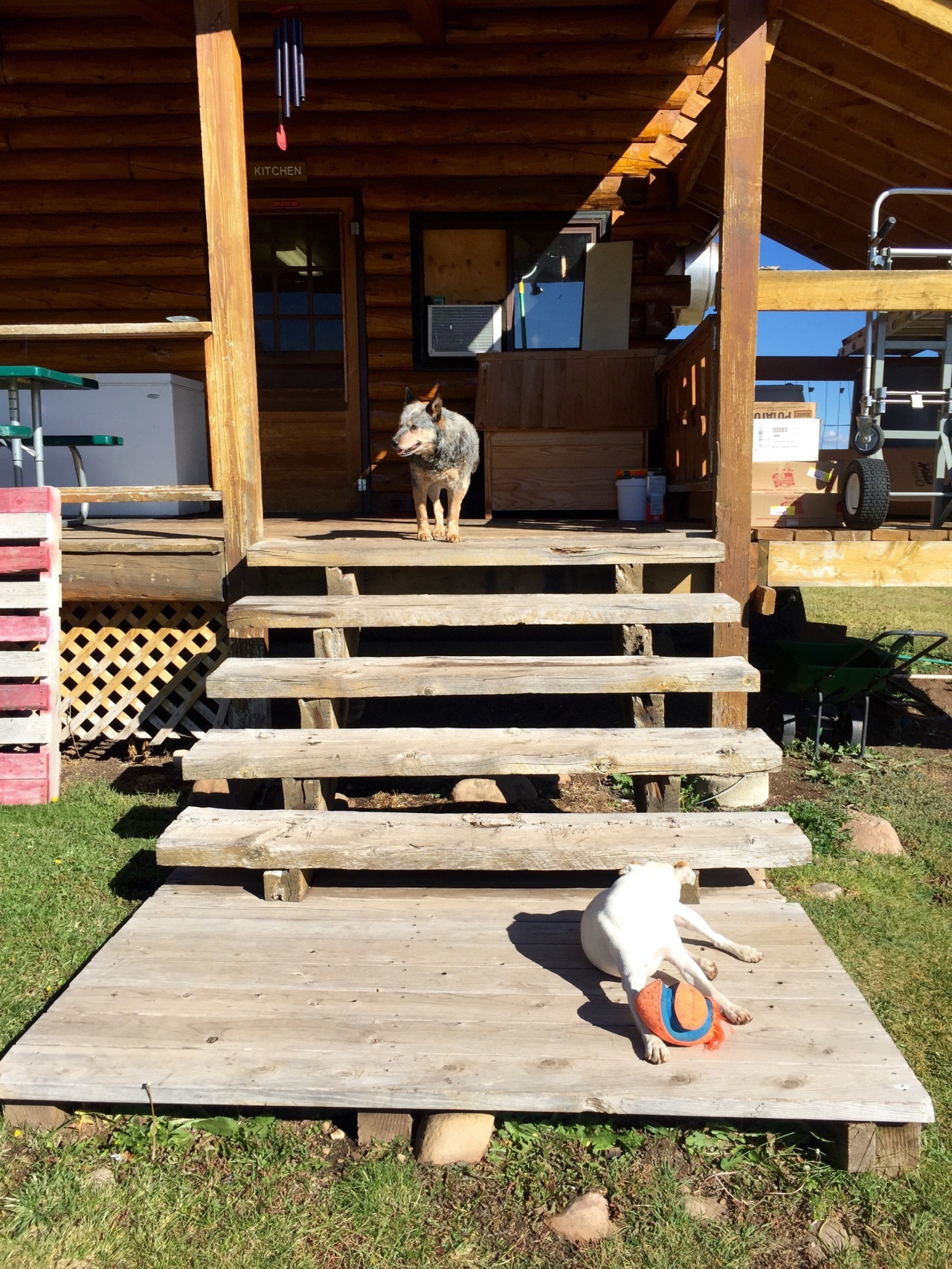
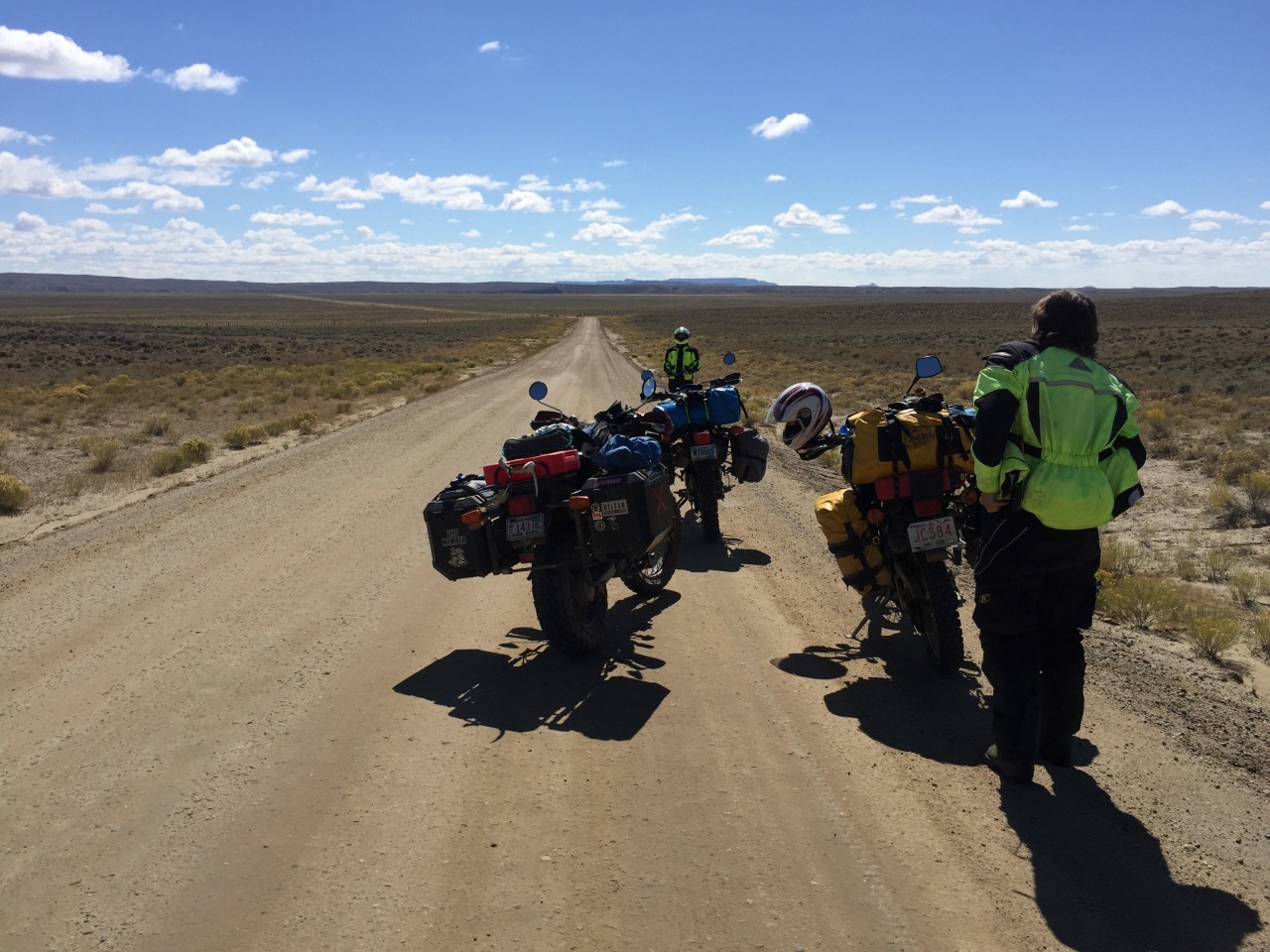
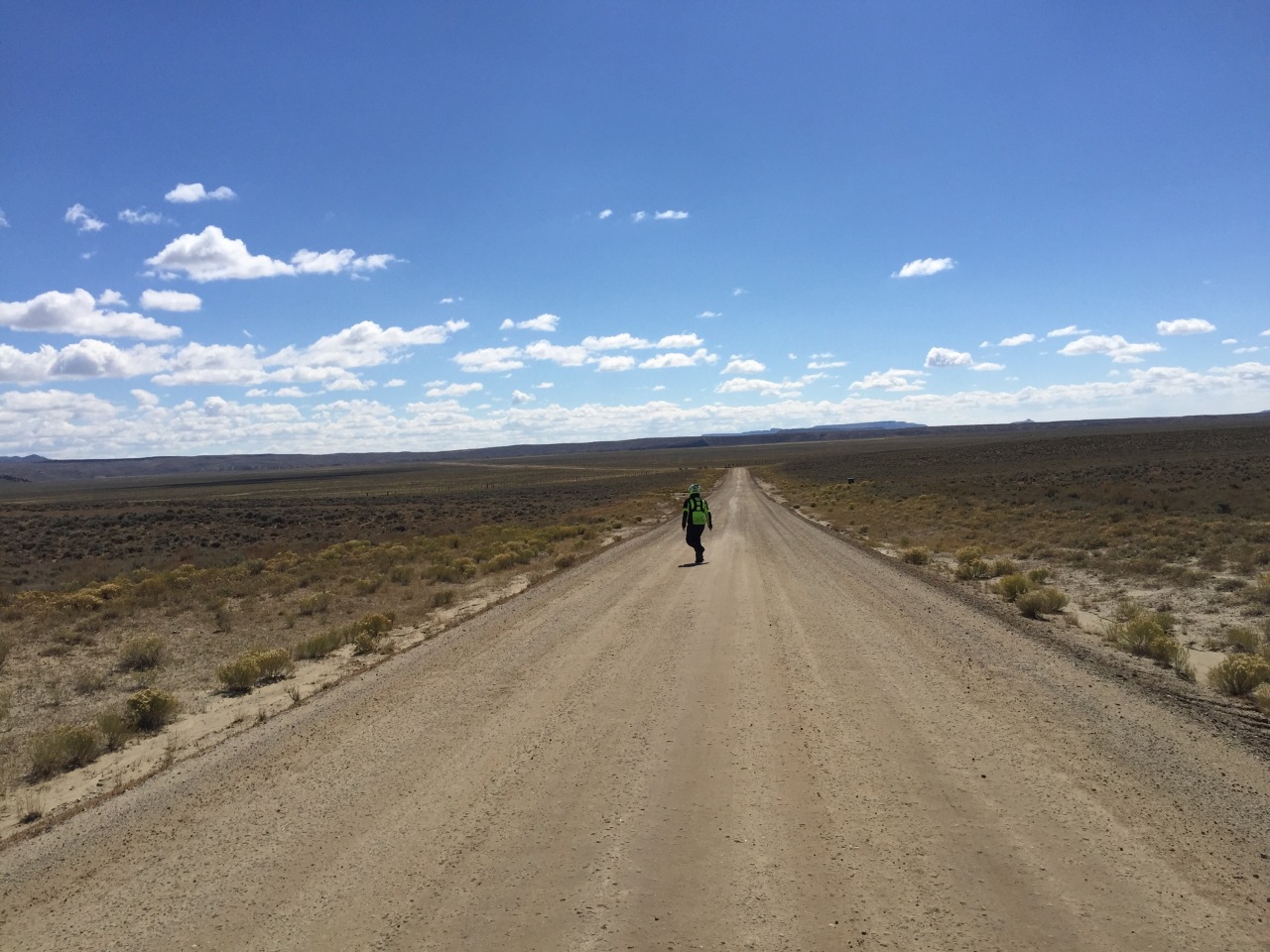



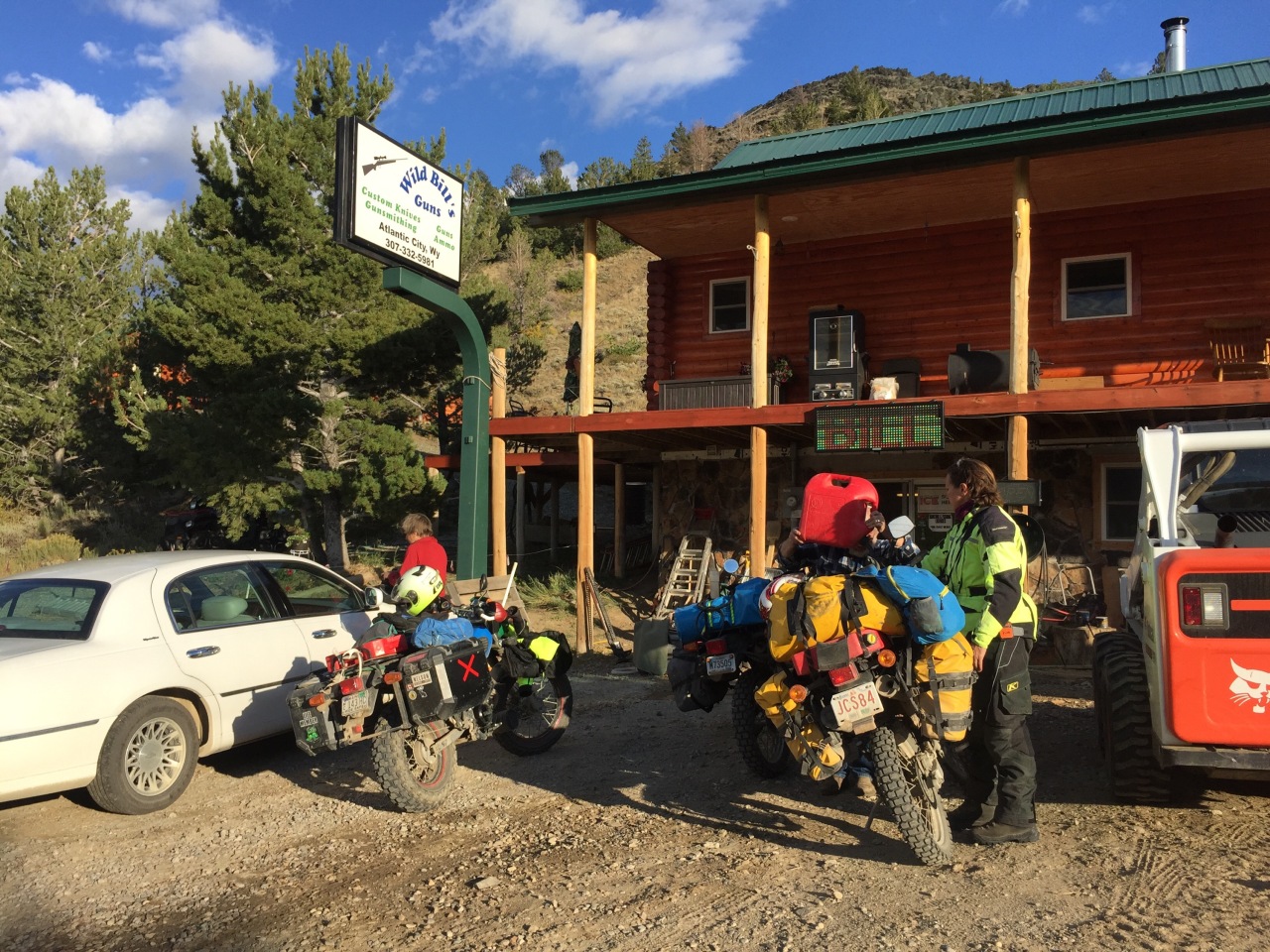

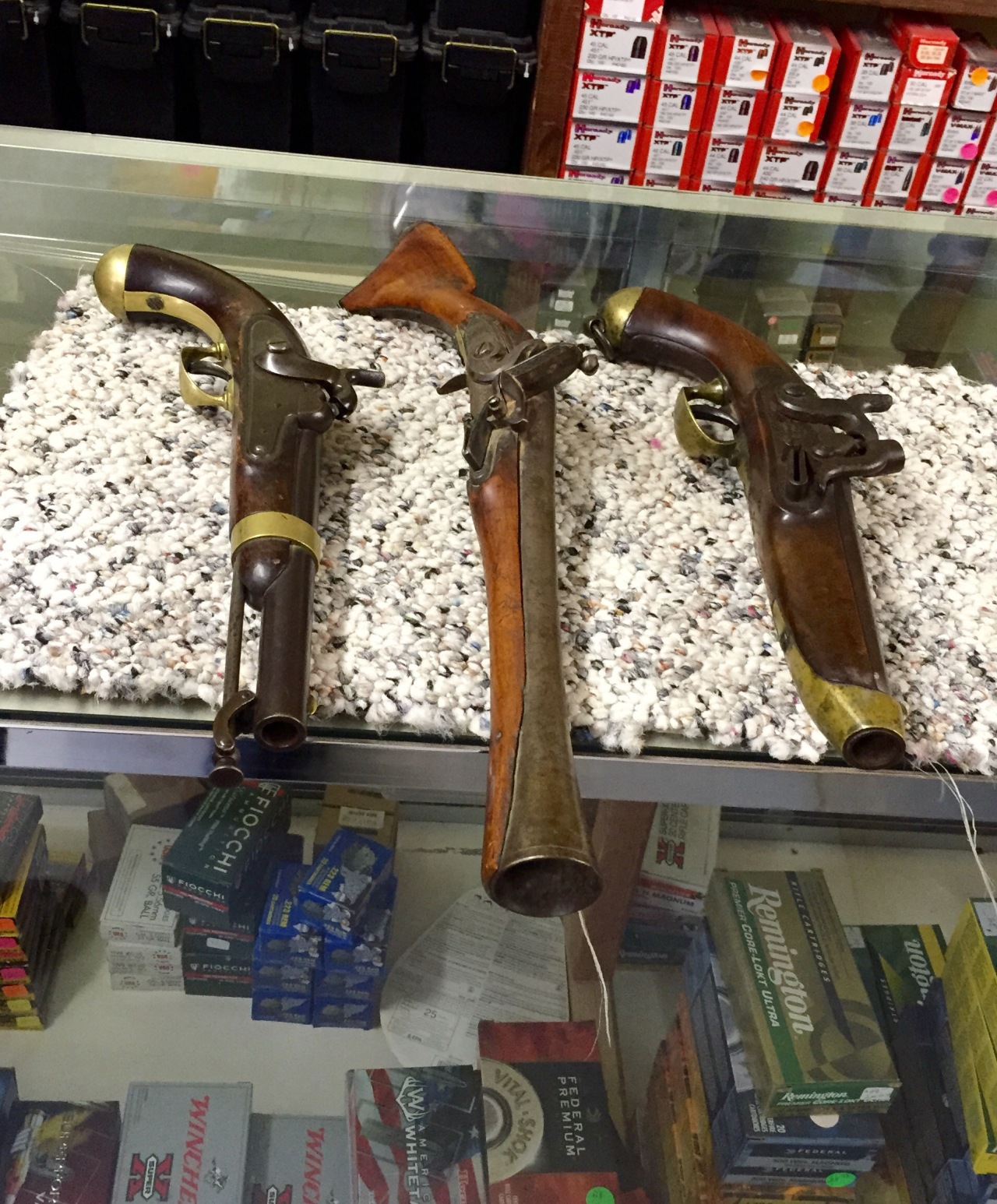
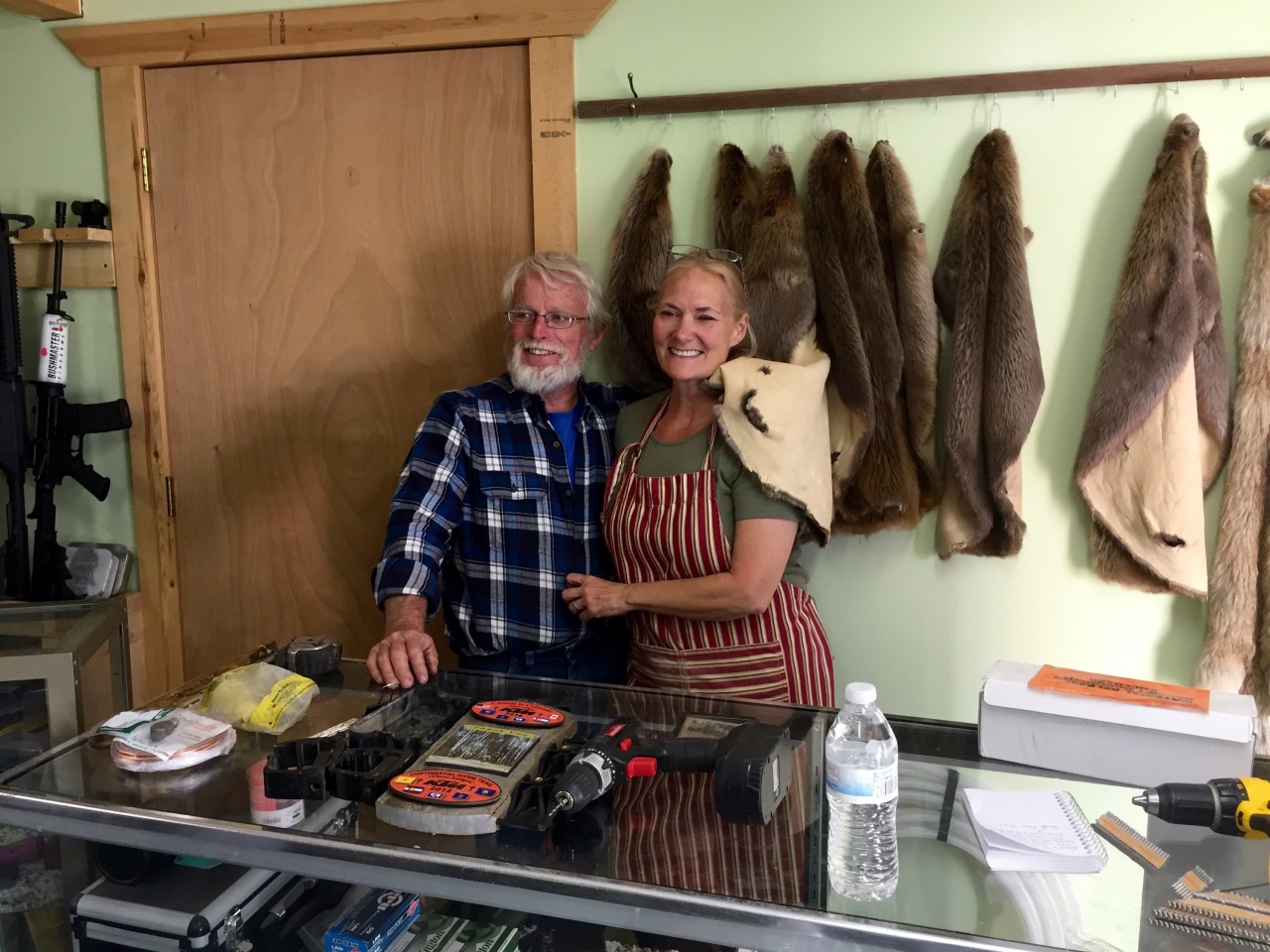
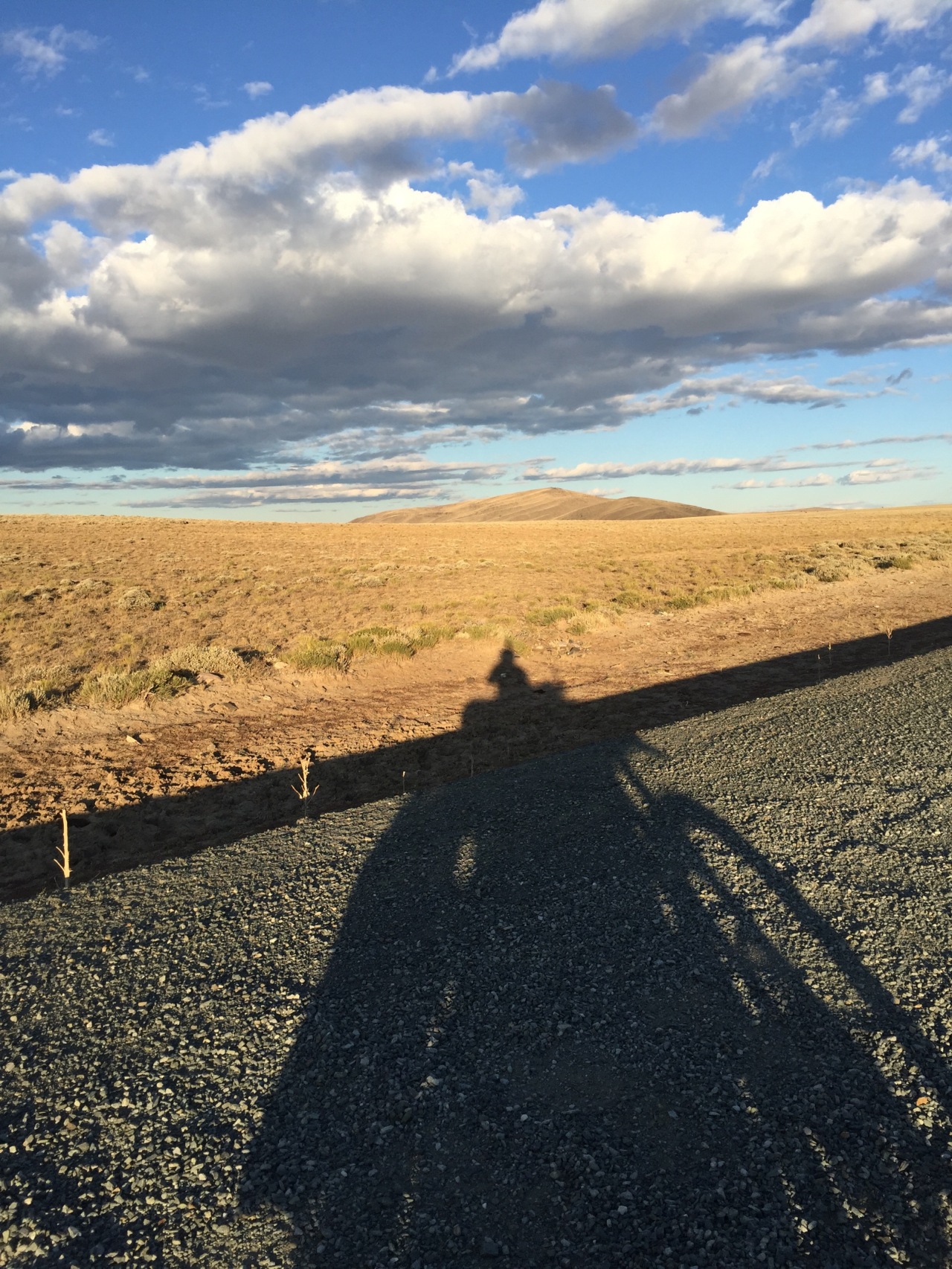
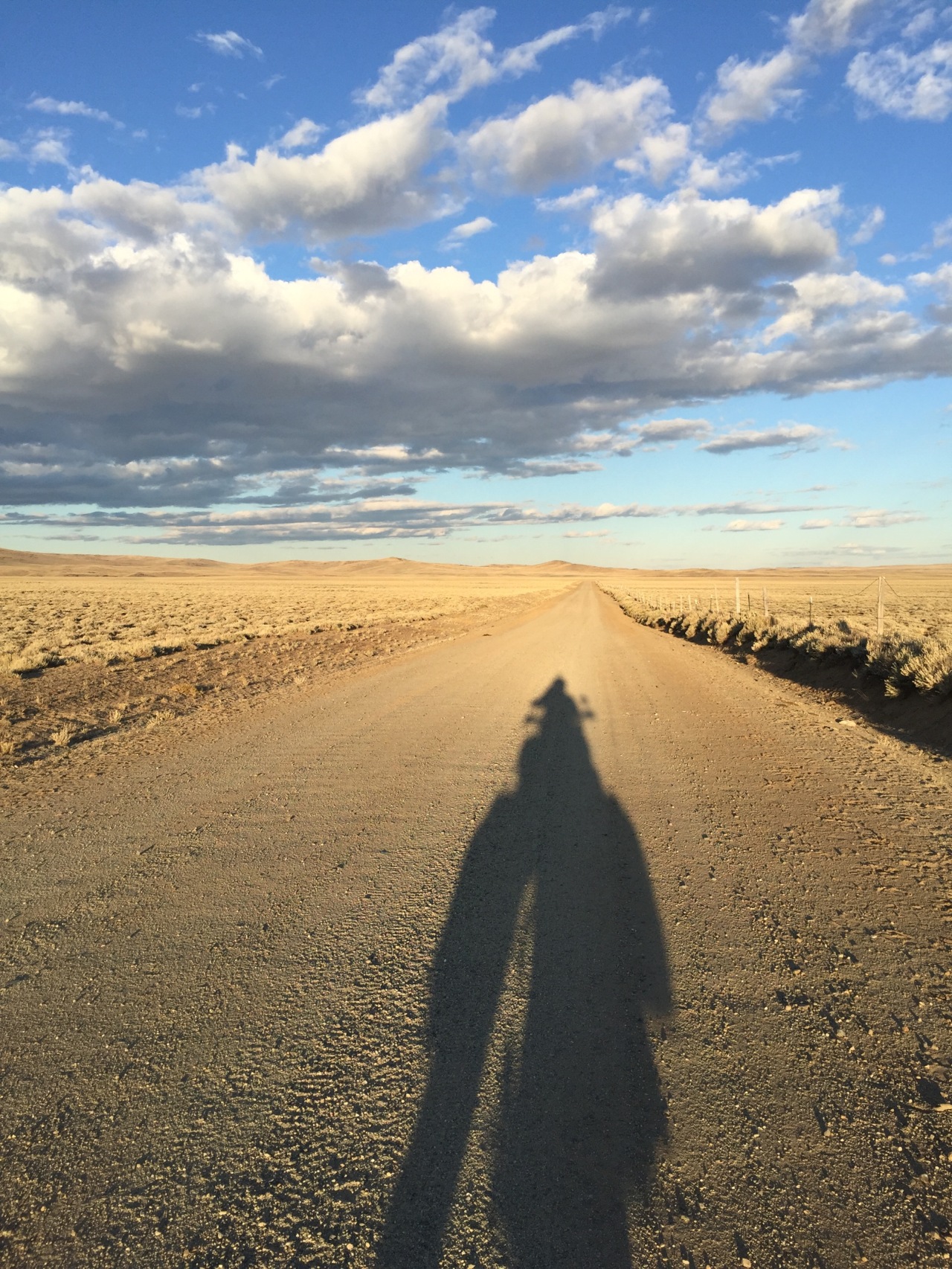



Looks like you had an amazing day, love those long dirt roads, that’s what freedom looks like
America, the beautiful! Thanks for sharing. Awesome pictures.
What a day, indeed. I thoroughly enjoyed that post and photos.
FWIW, the tune that Hernando, the Peruvian gent played, was likely “El Condor Pasa,” a traditional Andean song and not a version of a Simon and Garfunkel song. I, too, have been in Peru.
Ride safe!
An incredible, once in a lifetime kind of day! Thanks for sharing your beautiful pictures and telling this great travel story.
Thanks so much, for always being so kind and supportive. Wishing you well.
Josep and Judy here. Loved your tip postings. Photos so enticing. Need a different bike though. Hard to take BMW K 1200 2 up down some of those trails.
Hi guys! I’m sure some people can take the big bikes places I never could, but it’s not for me. I’m really enjoying the little bike. I look forward to seeing photos from your adventures. Hope you’re both well.
I really enjoyed Atlantic City. So much so I stayed in the area several days. The road from there to Boulder is really incredible. I saw the same sheep herder but did’t stop to visit.
What a small world! Thanks, Walter.
Just found your blog via Fuzzygalore. Loved your story of Hernandez! I think you brought to me, the same feelings you felt, as you were walking back to your bike.
Thank you, Derek 😊